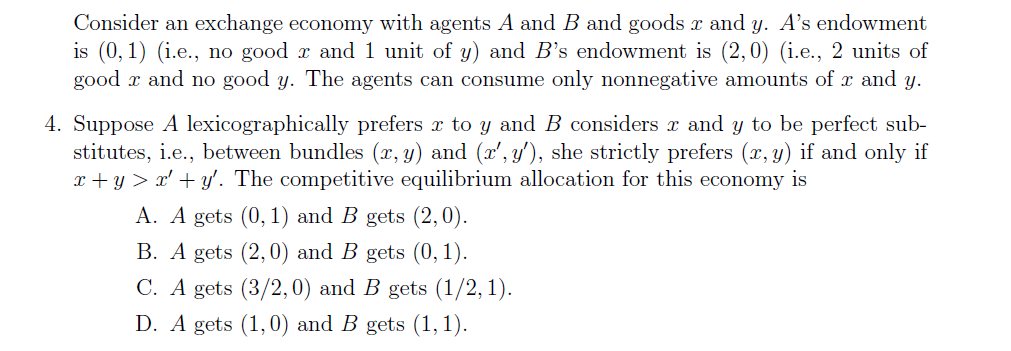Consider an exchange economy with agents A and B and goods x and y. A's endowment is (0, 1) (i.e., no good r and 1 unit of y) and B's endowment is (2,0) (i.e., 2 units of good x and no good y. The agents can consume only nonnegative amounts of x and y. 4. Suppose A lexicographically prefers r to y and B considers x and y to be perfect sub- stitutes, i.e., between bundles (x, y) and (x', y'), she strictly prefers (x, y) if and only if x + y > x' + y'. The competitive equilibrium allocation for this economy is A. A gets (0, 1) and B gets (2,0). B. A gets (2,0) and B gets (0, 1). C. A gets (3/2, 0) and B gets (1/2, 1). D. A gets (1, 0) and B gets (1,1).
Consider an exchange economy with agents A and B and goods x and y. A's endowment is (0, 1) (i.e., no good r and 1 unit of y) and B's endowment is (2,0) (i.e., 2 units of good x and no good y. The agents can consume only nonnegative amounts of x and y. 4. Suppose A lexicographically prefers r to y and B considers x and y to be perfect sub- stitutes, i.e., between bundles (x, y) and (x', y'), she strictly prefers (x, y) if and only if x + y > x' + y'. The competitive equilibrium allocation for this economy is A. A gets (0, 1) and B gets (2,0). B. A gets (2,0) and B gets (0, 1). C. A gets (3/2, 0) and B gets (1/2, 1). D. A gets (1, 0) and B gets (1,1).
Chapter13: General Equilibrium And Welfare
Section: Chapter Questions
Problem 13.5P
Related questions
Question
The questions are attached in the image. The model for the question is given in the first image. Please answer 3 questions using the information in the given model.
Please answer all the three question (4,6 and 7). Also, please provide a mathematical as well as intuitive solution for the questions.
More specifically what will be the
Thank you.
![6. Now suppose A lexicographically prefers y to x and B considers r and y to be perfect
substitutes. The set of all possible competitive equilibrium prices consists of all pr > 0
and py > 0 such that
A. Pæ/Py = 1
B. Pz/Py 2 1
C. Pz/Py < 1
D. Pz/Py > 0
7. Now suppose A lexicographically prefers y to x and B considers x and y to be perfect
complements. The set of competitive equilibrium allocations
A. includes the allocation (1,0) for A and (1,1) for B
B. includes the allocation (1,0) for A and (1, 1) for B
C. is empty
D. includes all allocations (x, 1) for A and (2 – r, 0) for B, where r e [0, 2]](/v2/_next/image?url=https%3A%2F%2Fcontent.bartleby.com%2Fqna-images%2Fquestion%2F39f4412a-18c0-4f64-8bcf-4dffb42656da%2Fd46e5d91-8127-4f43-a44d-e96d997ea610%2Fi3llbk_processed.png&w=3840&q=75)
Transcribed Image Text:6. Now suppose A lexicographically prefers y to x and B considers r and y to be perfect
substitutes. The set of all possible competitive equilibrium prices consists of all pr > 0
and py > 0 such that
A. Pæ/Py = 1
B. Pz/Py 2 1
C. Pz/Py < 1
D. Pz/Py > 0
7. Now suppose A lexicographically prefers y to x and B considers x and y to be perfect
complements. The set of competitive equilibrium allocations
A. includes the allocation (1,0) for A and (1,1) for B
B. includes the allocation (1,0) for A and (1, 1) for B
C. is empty
D. includes all allocations (x, 1) for A and (2 – r, 0) for B, where r e [0, 2]

Transcribed Image Text:Consider an exchange economy with agents A and B and goods x and y. A's endowment
is (0,1) (i.e., no good r and 1 unit of y) and B's endowment is (2,0) (i.e., 2 units of
good x and no good y. The agents can consume only nonnegative amounts of r and y.
4. Suppose A lexicographically prefers r to y and B considers r and y to be perfect sub-
stitutes, i.e., between bundles (x, y) and (x', y'), she strictly prefers (x, y) if and only if
x + y > x' + y'. The competitive equilibrium allocation for this economy is
A. A gets (0, 1) and B gets (2,0).
B. A gets (2,0) and B gets (0, 1).
C. A gets (3/2,0) and B gets (1/2, 1).
D. A gets (1,0) and B gets (1, 1).
Expert Solution
This question has been solved!
Explore an expertly crafted, step-by-step solution for a thorough understanding of key concepts.
This is a popular solution!
Trending now
This is a popular solution!
Step by step
Solved in 4 steps

Recommended textbooks for you

